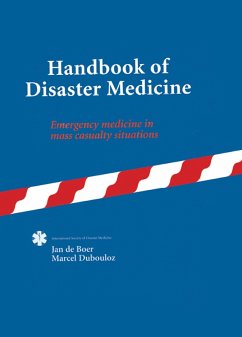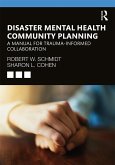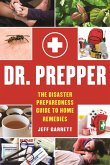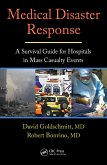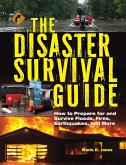Handbook of Disaster Medicine (eBook, ePUB)
Redaktion: de Boer, Jan; Dubouloz, Marcel
208,95 €
208,95 €
inkl. MwSt.
Sofort per Download lieferbar

104 °P sammeln
208,95 €
Als Download kaufen

208,95 €
inkl. MwSt.
Sofort per Download lieferbar

104 °P sammeln
Jetzt verschenken
Alle Infos zum eBook verschenken
208,95 €
inkl. MwSt.
Sofort per Download lieferbar
Alle Infos zum eBook verschenken

104 °P sammeln
Handbook of Disaster Medicine (eBook, ePUB)
Redaktion: de Boer, Jan; Dubouloz, Marcel
- Format: ePub
- Merkliste
- Auf die Merkliste
- Bewerten Bewerten
- Teilen
- Produkt teilen
- Produkterinnerung
- Produkterinnerung

Bitte loggen Sie sich zunächst in Ihr Kundenkonto ein oder registrieren Sie sich bei
bücher.de, um das eBook-Abo tolino select nutzen zu können.
Hier können Sie sich einloggen
Hier können Sie sich einloggen
Sie sind bereits eingeloggt. Klicken Sie auf 2. tolino select Abo, um fortzufahren.

Bitte loggen Sie sich zunächst in Ihr Kundenkonto ein oder registrieren Sie sich bei bücher.de, um das eBook-Abo tolino select nutzen zu können.
Technological development has not only provided mankind with more prosperity, but with increased destructive power as well. These developments, combined with an explosive growth of the world population, have led to mass casualty situations, varying from traffic accidents to war.
- Geräte: eReader
- ohne Kopierschutz
- eBook Hilfe
- Größe: 2.05MB
Andere Kunden interessierten sich auch für
![Disaster Mental Health Community Planning (eBook, ePUB) Disaster Mental Health Community Planning (eBook, ePUB)]() Robert W. SchmidtDisaster Mental Health Community Planning (eBook, ePUB)34,95 €
Robert W. SchmidtDisaster Mental Health Community Planning (eBook, ePUB)34,95 €![Handbook of Cosmetic Science and Technology (eBook, ePUB) Handbook of Cosmetic Science and Technology (eBook, ePUB)]() Handbook of Cosmetic Science and Technology (eBook, ePUB)177,95 €
Handbook of Cosmetic Science and Technology (eBook, ePUB)177,95 €![Dr. Prepper (eBook, ePUB) Dr. Prepper (eBook, ePUB)]() Jeff GarrettDr. Prepper (eBook, ePUB)12,85 €
Jeff GarrettDr. Prepper (eBook, ePUB)12,85 €![Immigration, Cultural Identity, and Mental Health (eBook, ePUB) Immigration, Cultural Identity, and Mental Health (eBook, ePUB)]() Eugenio M. RotheImmigration, Cultural Identity, and Mental Health (eBook, ePUB)42,95 €
Eugenio M. RotheImmigration, Cultural Identity, and Mental Health (eBook, ePUB)42,95 €![Sharing the Front Line and the Back Hills (eBook, ePUB) Sharing the Front Line and the Back Hills (eBook, ePUB)]() Yael DanieliSharing the Front Line and the Back Hills (eBook, ePUB)54,95 €
Yael DanieliSharing the Front Line and the Back Hills (eBook, ePUB)54,95 €![Medical Disaster Response (eBook, ePUB) Medical Disaster Response (eBook, ePUB)]() Medical Disaster Response (eBook, ePUB)140,95 €
Medical Disaster Response (eBook, ePUB)140,95 €![The Disaster Survival Guide (eBook, ePUB) The Disaster Survival Guide (eBook, ePUB)]() Marie D. JonesThe Disaster Survival Guide (eBook, ePUB)11,95 €
Marie D. JonesThe Disaster Survival Guide (eBook, ePUB)11,95 €-
-
-
Technological development has not only provided mankind with more prosperity, but with increased destructive power as well. These developments, combined with an explosive growth of the world population, have led to mass casualty situations, varying from traffic accidents to war.
Dieser Download kann aus rechtlichen Gründen nur mit Rechnungsadresse in A, B, BG, CY, CZ, D, DK, EW, E, FIN, F, GR, HR, H, IRL, I, LT, L, LR, M, NL, PL, P, R, S, SLO, SK ausgeliefert werden.
Produktdetails
- Produktdetails
- Verlag: Taylor & Francis eBooks
- Seitenzahl: 596
- Erscheinungstermin: 28. April 2020
- Englisch
- ISBN-13: 9781000083187
- Artikelnr.: 59340784
- Verlag: Taylor & Francis eBooks
- Seitenzahl: 596
- Erscheinungstermin: 28. April 2020
- Englisch
- ISBN-13: 9781000083187
- Artikelnr.: 59340784
- Herstellerkennzeichnung Die Herstellerinformationen sind derzeit nicht verfügbar.
Jan de Boer, Marcel Dubouloz
PART ONE - MEDICAL CARE. Chapter 1 Surgery and traumatology - surgical management of severely injured patients when resources are limited: Introduction
Management in hospital
Head injuries
Chest injuries
Abdominal injuries
Limb injuries
Adapted surgical technologies. Chapter 2 Anaesthesiology and resuscitation: Introduction
The context of anaesthesia in disasters
Patient population
Primary anaesthetic skills
Cardiopulmonary resuscitation
Advanced anaesthetic skills
Logistics
Training and education. Chapter 3 Chemical injuries: Introduction
Mechanism of toxic injury
Medical preparedness plan
Medical action plan
Decontamination
Triage
Medical care at the scene
Management in medical facilities
Disaster follow-up. Chapter 4 Communicable diseases: General overview
Coping with communicable diseases in emergencies
Intervention strategies
Standard activities: tools
Therapeutic approaches
health education
Setting priorities. Chapter 5 Mental health: Introduction
Post-traumatic reactions
Management of the psychological and social component in disasters
Vulnerable groups
Prevention
The cultural aspect of mental health in disasters and complex emergencies. Chapter 6 Radiation injuries: Introduction
Technical considerations
Irradiation accidents
Clinical and biological consequences of exposure to ionising radiation - therapeutic approach
Management and communication during irradiation incidents. PART TWO - PUBLIC HEALTH. Chapter 1 Epidemiology: Disaster epidemiology
Application of epidemiology in disasters
Complex humanitarian disasters. Chapter 2 Environmental health: Introduction
Interaction between a population and its environment
Problems caused by exceptional situations
Water
Environment sanitation
Housing and energy. Chapter 3 Nutrition: Introduction
Nutritional assessment
Determining nutritional requirements
Management of a nutritional emergency
Human resource development. PART THREE - DISASTER MANAGEMENT. Chapter 1 Definition, classification and scoring of disasters: Introduction
Methodology
Discussion
The medical severity index of disasters
Discussion. Chapter 2 Order in the chaos - modelling medical management in disasters: Introduction
The general picture
The turning point between accident and disaster
Capacities in the medical assistance chain
The medical rescue capacity
The medical transport capacity
The hospital treatment capacity
Definition, classification and assessment of disasters
Determination of medical disaster preparedness
Triage and the 1-6 hour period following a disaster. (Part contents).
Management in hospital
Head injuries
Chest injuries
Abdominal injuries
Limb injuries
Adapted surgical technologies. Chapter 2 Anaesthesiology and resuscitation: Introduction
The context of anaesthesia in disasters
Patient population
Primary anaesthetic skills
Cardiopulmonary resuscitation
Advanced anaesthetic skills
Logistics
Training and education. Chapter 3 Chemical injuries: Introduction
Mechanism of toxic injury
Medical preparedness plan
Medical action plan
Decontamination
Triage
Medical care at the scene
Management in medical facilities
Disaster follow-up. Chapter 4 Communicable diseases: General overview
Coping with communicable diseases in emergencies
Intervention strategies
Standard activities: tools
Therapeutic approaches
health education
Setting priorities. Chapter 5 Mental health: Introduction
Post-traumatic reactions
Management of the psychological and social component in disasters
Vulnerable groups
Prevention
The cultural aspect of mental health in disasters and complex emergencies. Chapter 6 Radiation injuries: Introduction
Technical considerations
Irradiation accidents
Clinical and biological consequences of exposure to ionising radiation - therapeutic approach
Management and communication during irradiation incidents. PART TWO - PUBLIC HEALTH. Chapter 1 Epidemiology: Disaster epidemiology
Application of epidemiology in disasters
Complex humanitarian disasters. Chapter 2 Environmental health: Introduction
Interaction between a population and its environment
Problems caused by exceptional situations
Water
Environment sanitation
Housing and energy. Chapter 3 Nutrition: Introduction
Nutritional assessment
Determining nutritional requirements
Management of a nutritional emergency
Human resource development. PART THREE - DISASTER MANAGEMENT. Chapter 1 Definition, classification and scoring of disasters: Introduction
Methodology
Discussion
The medical severity index of disasters
Discussion. Chapter 2 Order in the chaos - modelling medical management in disasters: Introduction
The general picture
The turning point between accident and disaster
Capacities in the medical assistance chain
The medical rescue capacity
The medical transport capacity
The hospital treatment capacity
Definition, classification and assessment of disasters
Determination of medical disaster preparedness
Triage and the 1-6 hour period following a disaster. (Part contents).
PART ONE - MEDICAL CARE. Chapter 1 Surgery and traumatology - surgical management of severely injured patients when resources are limited: Introduction
Management in hospital
Head injuries
Chest injuries
Abdominal injuries
Limb injuries
Adapted surgical technologies. Chapter 2 Anaesthesiology and resuscitation: Introduction
The context of anaesthesia in disasters
Patient population
Primary anaesthetic skills
Cardiopulmonary resuscitation
Advanced anaesthetic skills
Logistics
Training and education. Chapter 3 Chemical injuries: Introduction
Mechanism of toxic injury
Medical preparedness plan
Medical action plan
Decontamination
Triage
Medical care at the scene
Management in medical facilities
Disaster follow-up. Chapter 4 Communicable diseases: General overview
Coping with communicable diseases in emergencies
Intervention strategies
Standard activities: tools
Therapeutic approaches
health education
Setting priorities. Chapter 5 Mental health: Introduction
Post-traumatic reactions
Management of the psychological and social component in disasters
Vulnerable groups
Prevention
The cultural aspect of mental health in disasters and complex emergencies. Chapter 6 Radiation injuries: Introduction
Technical considerations
Irradiation accidents
Clinical and biological consequences of exposure to ionising radiation - therapeutic approach
Management and communication during irradiation incidents. PART TWO - PUBLIC HEALTH. Chapter 1 Epidemiology: Disaster epidemiology
Application of epidemiology in disasters
Complex humanitarian disasters. Chapter 2 Environmental health: Introduction
Interaction between a population and its environment
Problems caused by exceptional situations
Water
Environment sanitation
Housing and energy. Chapter 3 Nutrition: Introduction
Nutritional assessment
Determining nutritional requirements
Management of a nutritional emergency
Human resource development. PART THREE - DISASTER MANAGEMENT. Chapter 1 Definition, classification and scoring of disasters: Introduction
Methodology
Discussion
The medical severity index of disasters
Discussion. Chapter 2 Order in the chaos - modelling medical management in disasters: Introduction
The general picture
The turning point between accident and disaster
Capacities in the medical assistance chain
The medical rescue capacity
The medical transport capacity
The hospital treatment capacity
Definition, classification and assessment of disasters
Determination of medical disaster preparedness
Triage and the 1-6 hour period following a disaster. (Part contents).
Management in hospital
Head injuries
Chest injuries
Abdominal injuries
Limb injuries
Adapted surgical technologies. Chapter 2 Anaesthesiology and resuscitation: Introduction
The context of anaesthesia in disasters
Patient population
Primary anaesthetic skills
Cardiopulmonary resuscitation
Advanced anaesthetic skills
Logistics
Training and education. Chapter 3 Chemical injuries: Introduction
Mechanism of toxic injury
Medical preparedness plan
Medical action plan
Decontamination
Triage
Medical care at the scene
Management in medical facilities
Disaster follow-up. Chapter 4 Communicable diseases: General overview
Coping with communicable diseases in emergencies
Intervention strategies
Standard activities: tools
Therapeutic approaches
health education
Setting priorities. Chapter 5 Mental health: Introduction
Post-traumatic reactions
Management of the psychological and social component in disasters
Vulnerable groups
Prevention
The cultural aspect of mental health in disasters and complex emergencies. Chapter 6 Radiation injuries: Introduction
Technical considerations
Irradiation accidents
Clinical and biological consequences of exposure to ionising radiation - therapeutic approach
Management and communication during irradiation incidents. PART TWO - PUBLIC HEALTH. Chapter 1 Epidemiology: Disaster epidemiology
Application of epidemiology in disasters
Complex humanitarian disasters. Chapter 2 Environmental health: Introduction
Interaction between a population and its environment
Problems caused by exceptional situations
Water
Environment sanitation
Housing and energy. Chapter 3 Nutrition: Introduction
Nutritional assessment
Determining nutritional requirements
Management of a nutritional emergency
Human resource development. PART THREE - DISASTER MANAGEMENT. Chapter 1 Definition, classification and scoring of disasters: Introduction
Methodology
Discussion
The medical severity index of disasters
Discussion. Chapter 2 Order in the chaos - modelling medical management in disasters: Introduction
The general picture
The turning point between accident and disaster
Capacities in the medical assistance chain
The medical rescue capacity
The medical transport capacity
The hospital treatment capacity
Definition, classification and assessment of disasters
Determination of medical disaster preparedness
Triage and the 1-6 hour period following a disaster. (Part contents).
